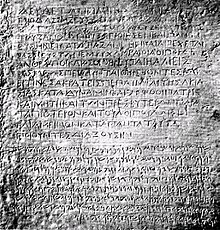| This is a Wikipedia
user page. This is not an encyclopedia article or the talk page for an encyclopedia article. If you find this page on any site other than Wikipedia, you are viewing a mirror site. Be aware that the page may be outdated and that the user in whose space this page is located may have no personal affiliation with any site other than Wikipedia. The original page is located at https://en.wikipedia.org/wiki/User:HistoryofIran/Kambojas. |

The Kambojas were a southeastern Iranian people [a] who inhabited the northeastern most part of the territory populated by Iranian tribes, which bordered the Indian lands. They only appear in Indo-Aryan inscriptions and literature, being first attested during the later part of the Vedic period.
They spoke a language similar to Younger Avestan, whose words are considered to have been incorporated in the Aramao-Iranian version of the Kandahar Bilingual Rock Inscription erected by the Maurya emperor Ashoka ( r. 268–232 BCE). They were adherents of Zoroastrianism, as demonstrated by their beliefs that insects, snakes, worms, frogs, and other small animals had to be killed, a practice mentioned in the Avestan Vendidad.
| This is a Wikipedia
user page. This is not an encyclopedia article or the talk page for an encyclopedia article. If you find this page on any site other than Wikipedia, you are viewing a mirror site. Be aware that the page may be outdated and that the user in whose space this page is located may have no personal affiliation with any site other than Wikipedia. The original page is located at https://en.wikipedia.org/wiki/User:HistoryofIran/Kambojas. |

The Kambojas were a southeastern Iranian people [a] who inhabited the northeastern most part of the territory populated by Iranian tribes, which bordered the Indian lands. They only appear in Indo-Aryan inscriptions and literature, being first attested during the later part of the Vedic period.
They spoke a language similar to Younger Avestan, whose words are considered to have been incorporated in the Aramao-Iranian version of the Kandahar Bilingual Rock Inscription erected by the Maurya emperor Ashoka ( r. 268–232 BCE). They were adherents of Zoroastrianism, as demonstrated by their beliefs that insects, snakes, worms, frogs, and other small animals had to be killed, a practice mentioned in the Avestan Vendidad.